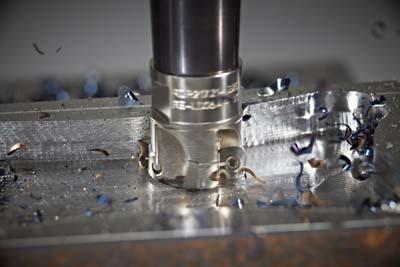
The new High Feed 2 line of small diameter high feed milling tools from Seco Tools focuses on bringing high levels of productivity and reliability to modern CNC machines. Offering high feed rates and small depths of cut, High Feed 2 cutters can handle a wide variety of applications, including pocketing, ramping, helical interpolation, facing, contouring, slotting and plunging. Cutting diameters range from .625" to 1.25".
The line includes a comprehensive range of PVD and CVD insert grades for hard steels up to 62 HRC and a wide variety of chip groove and flat geometries to effectively tackle several different types of materials, including superalloys. The chip groove geometries also allow for soft cutting in steel, stainless steel and other gummy materials.
High Feed 2 cutters achieve maximum removal rates through a combination of strength and number of teeth versus diameter. A close pitch allows very fast feed rates and stable cutting performance, even in in interrupted cuts. Furthermore, the well-balanced design of the cutter body and inserts enables free chip flow in copy milling, particularly when using toolholders with long overhangs. The High Feed 2 line also provides higher security through an optimized screw and torx socket size, a maximized insert cross section and an outside radius to prevent chipping.
Contact Details
Related Glossary Terms
- chemical vapor deposition ( CVD)
chemical vapor deposition ( CVD)
High-temperature (1,000° C or higher), atmosphere-controlled process in which a chemical reaction is induced for the purpose of depositing a coating 2µm to 12µm thick on a tool’s surface. See coated tools; PVD, physical vapor deposition.
- computer numerical control ( CNC)
computer numerical control ( CNC)
Microprocessor-based controller dedicated to a machine tool that permits the creation or modification of parts. Programmed numerical control activates the machine’s servos and spindle drives and controls the various machining operations. See DNC, direct numerical control; NC, numerical control.
- feed
feed
Rate of change of position of the tool as a whole, relative to the workpiece while cutting.
- flat ( screw flat)
flat ( screw flat)
Flat surface machined into the shank of a cutting tool for enhanced holding of the tool.
- gang cutting ( milling)
gang cutting ( milling)
Machining with several cutters mounted on a single arbor, generally for simultaneous cutting.
- interpolation
interpolation
Process of generating a sufficient number of positioning commands for the servomotors driving the machine tool so the path of the tool closely approximates the ideal path. See CNC, computer numerical control; NC, numerical control.
- milling
milling
Machining operation in which metal or other material is removed by applying power to a rotating cutter. In vertical milling, the cutting tool is mounted vertically on the spindle. In horizontal milling, the cutting tool is mounted horizontally, either directly on the spindle or on an arbor. Horizontal milling is further broken down into conventional milling, where the cutter rotates opposite the direction of feed, or “up” into the workpiece; and climb milling, where the cutter rotates in the direction of feed, or “down” into the workpiece. Milling operations include plane or surface milling, endmilling, facemilling, angle milling, form milling and profiling.
- physical vapor deposition ( PVD)
physical vapor deposition ( PVD)
Tool-coating process performed at low temperature (500° C), compared to chemical vapor deposition (1,000° C). Employs electric field to generate necessary heat for depositing coating on a tool’s surface. See CVD, chemical vapor deposition.
- pitch
pitch
1. On a saw blade, the number of teeth per inch. 2. In threading, the number of threads per inch.
- slotting
slotting
Machining, normally milling, that creates slots, grooves and similar recesses in workpieces, including T-slots and dovetails.
- superalloys
superalloys
Tough, difficult-to-machine alloys; includes Hastelloy, Inconel and Monel. Many are nickel-base metals.

